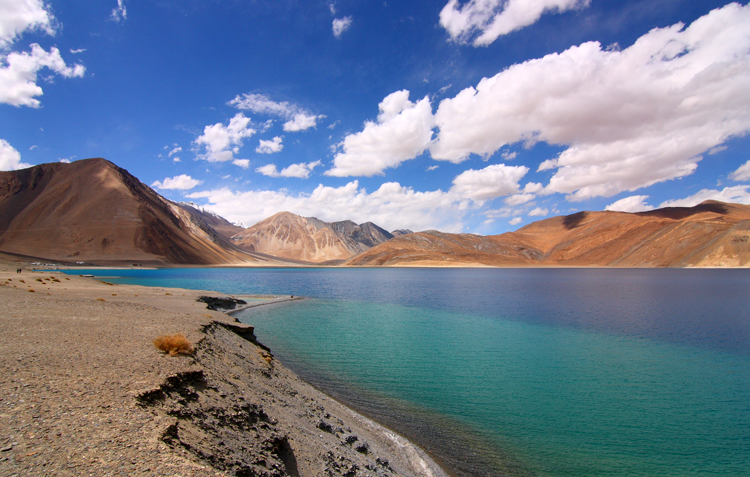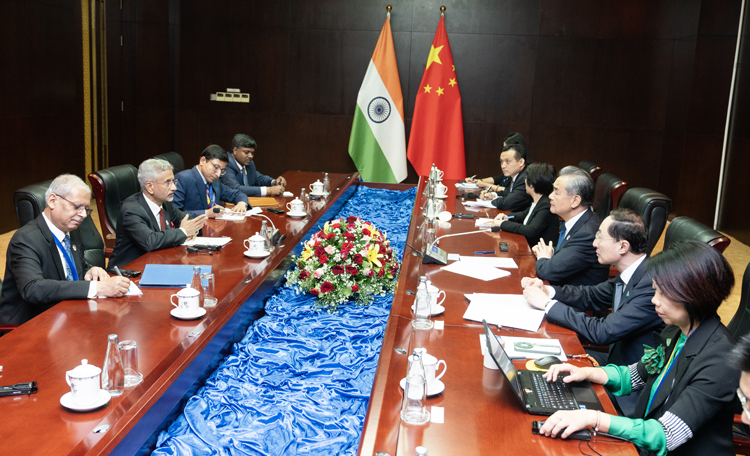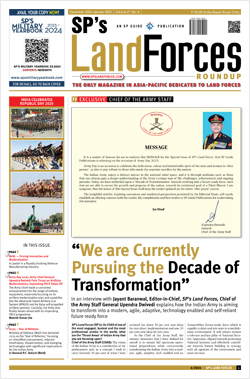INDIAN ARMED FORCES CHIEFS ON OUR RELENTLESS AND FOCUSED PUBLISHING EFFORTS

The insightful articles, inspiring narrations and analytical perspectives presented by the Editorial Team, establish an alluring connect with the reader. My compliments and best wishes to SP Guide Publications.

"Over the past 60 years, the growth of SP Guide Publications has mirrored the rising stature of Indian Navy. Its well-researched and informative magazines on Defence and Aerospace sector have served to shape an educated opinion of our military personnel, policy makers and the public alike. I wish SP's Publication team continued success, fair winds and following seas in all future endeavour!"

Since, its inception in 1964, SP Guide Publications has consistently demonstrated commitment to high-quality journalism in the aerospace and defence sectors, earning a well-deserved reputation as Asia's largest media house in this domain. I wish SP Guide Publications continued success in its pursuit of excellence.
- MoD initiates comprehensive review of Defence Acquisition Procedure 2020, pushes for defence reforms
- G7: The Swansong
- Kalinga Connect: South Asia to Polynesia
- Must Credit DRDO for Operation Sindoor, now what is next for defence R&D?
- The layered Air Defence systems that worked superbly, the key element of Operation Sindoor
- Operation Sindoor | Day 2 DGMOs Briefing
- Operation Sindoor: Resolute yet Restrained
China's New Pangong Tso Bridge
China's construction of a new 400-meter bridge across Pangong Tso, with satellite images showing armoured vehicles on it, has strategic implications for faster PLA mobilisation and shifts the power balance in favour of China
 |
The Author is Former Director General of Information Systems and A Special Forces Veteran, Indian Army |

On July 25, 2024, External Affairs Minister S. Jaishankar met China's Foreign Minister Wang Yi on the sidelines of the ASEAN Summit at Vientiane, Laos. Both reportedly agreed on 'strong guidance' to end the LAC impasse – completing disengagement in eastern Ladakh. A Ministry of External Affairs statement said the talks focused on finding an early resolution to remaining issues along the LAC to stabilise and rebuild bilateral relations and both ministers agreed on the need to work with purpose and urgency to achieve complete disengagement at the earliest. However, the Chinese statement did not specifically mention the need to expedite disengagement, but said the two sides agreed to work together to maintain peace and promote "new progress" in border areas consultation, and that Wang stressed normalcy in Sino-Indian ties is also a common expectation of the Global South.
China has been signaling that the PLA will not move back from its positions occupied in 2020, where it has consolidated. Presently, China holds all the aces.
The above was followed by the 30th meeting of the Working Mechanism for Consultation & Coordination on India-China Border Affairs (WMCC) at New Delhi on July 31, 2024, where both sides reviewed the situation along the LAC with a view to finding an early resolution of the outstanding issues. They agreed on the need to jointly uphold peace and tranquility on the ground in the border areas in accordance with relevant bilateral agreements, protocols and understandings reached between the two Governments.
There is speculation that China is mellowing down because of its economic situation and would ease the standoff but indications are to the contrary. China is a $19.3 trillion economy and India's manufacturing base is not even 10 per cent of China's. China has been signaling PLA will not move back anymore from its positions occupied in 2020, where it has consolidated. Presently, China holds all the aces. It is earning an annual profit of about $100 billion through India-China bilateral trade; more than before 2020 - India is helping modernise the PLA while China has hiked its defence budget by 7.2 per cent. Moreover, China has surpassed the US as India's top trading partner. To top this, India is now working on opening up Chinese investments in India and visa rules have been eased for Chinese technicians to work in India.
Ironically, India vacated the Kailash Range without demanding simultaneous PLA withdrawal from Depsang and Demchok, which was a strategic blunder
China recently completed construction of a new 400 meter bridge across Pangong Tso; satellite pictures show armoured vehicles plying on the bridge. This bridge has strategic implications in terms of: faster PLA mobilisation and rapid deployment for a quick offensive; the bridge, combined with other infrastructure developments, shifts the power balance in favour of China – deterring possible Indian assertive action; it underscores the geopolitical India-China competition for influence in the region; located 20 km east of Finger 10 on Pangong Tso where China has deployed tanks, it raises suspicion about disengagement and China's long-term military strategy in Ladakh.

During the standoff along the LAC, China built a new road to its Moldo garrison on the north bank of Pangong Tso (between September 2020 and mid-2021) to obviate observation by Indian troops atop Kailash Range. Ironically, India vacated the Kailash Range without demanding simultaneous PLA withdrawal from Depsang and Demchok, which was a strategic blunder.
China's Pangong Tso bridge represents a multifaceted challenge for India, enhancing China's military logistics and asserting its claims over disputed territory. This development not only heightens military tensions but also impacts the local populace, who are left to navigate the uncertainties of an increasingly militarized border region. It is a complex issue with geopolitical implications, and the situation is constantly evolving.
China has begun constructing dual-use military villages along the LAC, including one in Arunachal Pradesh and three inside Bhutan, signaling its expanding military infrastructure and strategic depth against India
In July 2022, China announced its second expressway through Aksai Chin, the G-695 highway, which will reportedly run close to Galwan and Hot Springs in eastern Ladakh. China plans to complete this highway by 2035, which may be earlier looking at China's pace of developing border infrastructure. Importantly, China annexed Aksai Chin to give depth to China's National Highway 219. Hence, China will definitely attempt to acquire a larger chunk of Ladakh to provide depth to its G-695 highway much before it reaches anywhere close to Galwan and Hot Springs.
While Jaishankar-Wang and the WMCC were discussing disengagement and tranquility along the border, China has begun construction of a dual-use military village along the LAC in Demchok. In fact, China has constructed, what is being a "wall of villages" against India. During the standoff, China constructed one dual-use military village in Arunachal Pradesh and three inside Bhutan. According to US analysts, China's dual-use military villages have integrated electronic warfare (EW) and air defence (AD) elements.
We need to be fully prepared for a 1962 type of situation, for which the politico-bureaucratic hierarchy seems to believe there is no need
According to some western analysts, a US-China war is likely in three years from now and most agree that a US-China war could extend over years. In the case of India, are we crippled with the notion that there will be no war or that war (if at all) will be short and intense even after witnessing the war in Ukraine? We must acknowledge that China will test its systems, weapons and technology against India before it takes on the US, and the next full scale war will have the involvement of Pakistan and terror elements, insurgents and intelligence assets operating inside India.
Moreover, China has drawn India's immediate neighbours deeper into its strategic sphere. China-assisted construction of the largest submarine base for the Bangladesh Navy, which was inaugurated recently. The regime change in Bangladesh raises the possibility of a Bangladesh National Party (BNP) led coalition coming to power. BNP is pro-Pakistan and China, which signals an expanded China threat for India.
Handshakes and bland smiles of Wang Yi and Xi Jinping should not mislead us; Zhou en-Lai visited India in 1962 giving no indication of the Chinese invasion in the offing. Similarly, when Xi Jinping visited India in October 2019, he had already planned the invasion of eastern Ladakh and the Galwan action in 2020. We need to be fully prepared for a 1962 type of situation, for which the politico-bureaucratic hierarchy seems to believe there is no need.





